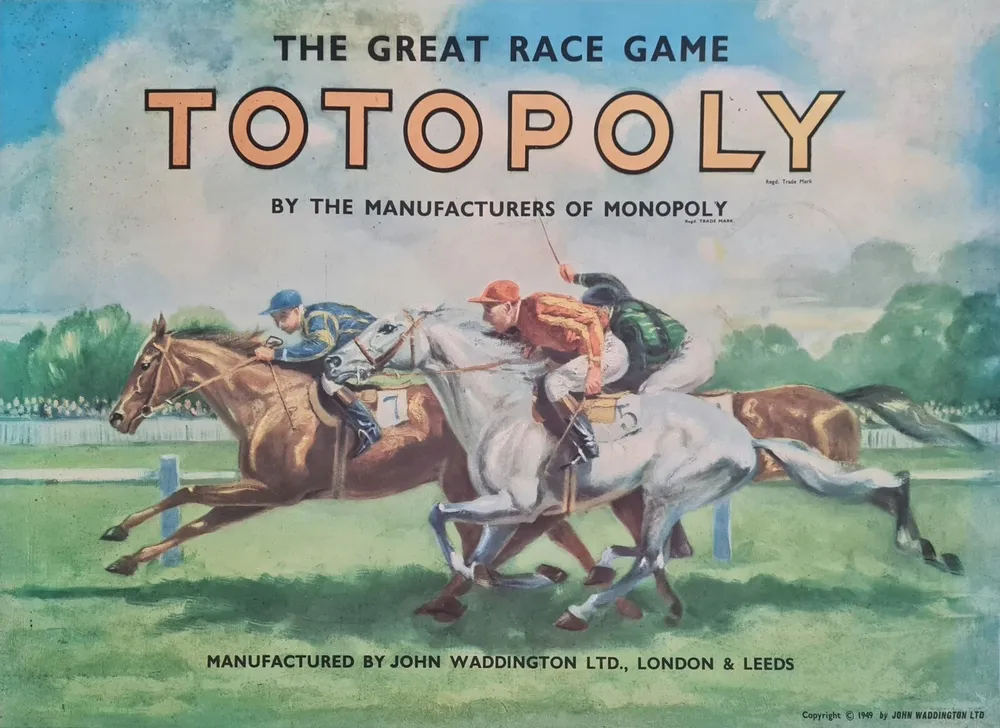Totopoly
Totopoly is a commercial board game based on the events leading up to and during a horse race. It was originally published in 1938 by Waddingtons.
Why is Totopoly Popular?
Totopoly is a classic board game that has been enjoyed by many generations. It is significant because it is one of the earliest horse racing board games and has been a favorite among horse racing enthusiasts. The game is also popular because it combines elements of strategy, luck, and betting, making it an exciting and engaging game for players of all ages.
Game Components of Totopoly
Double-sided board: Each side represents a different phase of the game.Horses: Named after winners of the Lincolnshire Handicap between 1926-37. Early editions featured hand-painted cast lead horses, while later versions used stamped, card, or plastic horses.Dice: Used for moving horses.Advantage and disadvantage cards: Affect horse movement and race outcomes.Totalisator cards: For betting and managing prize money.Rulebook: Includes original rules and notes by the inventors.
How To Setup Totopoly
Setting up Totopoly takes about 5-10 minutes. Players start by placing their horses in one of two stables on the first side of the board. Each player has a set of horses, and the game is ready to begin once all horses are positioned and the necessary cards are distributed.
Gameplay Mechanics and Game Objective
Phase 1: Players roll dice to move their horses around a loop on the first side of the board. Landing on certain squares allows players to collect advantage and disadvantage cards. Some horses may be eliminated during this phase.Phase 2: The actual horse race takes place on the second side of the board. Players can place bets on any horse before the race starts. Advantage cards can be used to improve a horse’s position, while disadvantage cards must be used, potentially hindering a horse’s progress.Betting and Prize Money: Players settle bets, and prize money is awarded for the top three finishers.Objective: In the original version, the winner is the player whose horse comes in first. In more recent editions, the winner is the player with the most money at the end of the game.
Player Experience
Playing Totopoly is a mix of luck and strategic betting. The game is designed for 3-6 players and typically lasts about 90 minutes. The high element of chance, through dice rolling and card drawing, makes each game unique and unpredictable.
Pros
Engaging Theme: The horse racing theme adds excitement and realism to the game.Strategic Depth: The use of advantage and disadvantage cards allows for strategic play.Social Interaction: Betting and competing against other players enhance the social aspect of the game.
Cons
Luck-Dependent: The game’s high chance element can make it less appealing to players who prefer strategy over luck.Complex Rules: The elaborate rules, especially for betting and prize money, can be confusing for new players.Design Flaw: The original version’s rule that the winner is determined solely by the first-place horse, regardless of money earned, has been criticized.
Personal Thoughts on Totopoly
Totopoly is ideal for those who enjoy racing games and are comfortable with a significant element of luck. It’s a great choice for groups looking for a social, interactive game with a unique theme. However, players who prefer games with more strategic depth or less reliance on chance might find Totopoly less appealing. The game’s historical significance and the nostalgic value of its early editions make it a collector’s item for some enthusiasts.
We are supported by our audience. When you purchase through links on our site, we may earn an affiliate commission, at no extra cost for you. Learn more.

